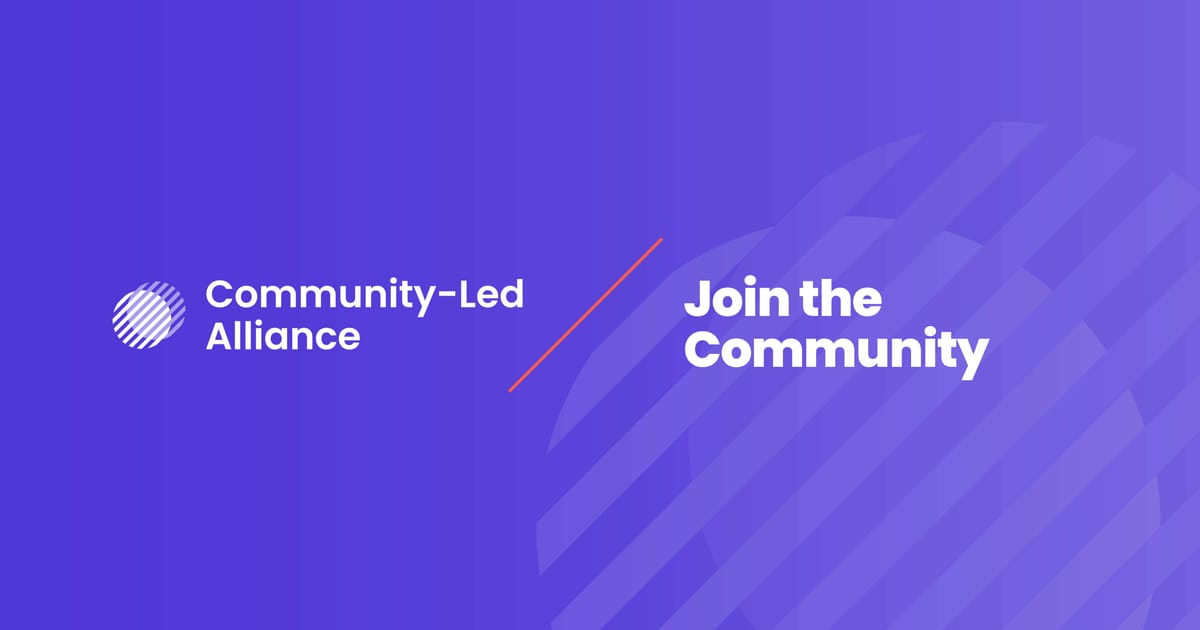Community management involves a wide array of activities, including overseeing, engaging, and fostering relationships with the community. It’s an essential role in today’s digital age, where so many brands, orgs, and groups strive to engage people and maintain vibrant communities.
However, managing such a community, despite being rewarding, also comes with its own challenges and hurdles—these can depend on how many members you have, the type of community you manage, etc.
We turned to the amazing Community Managers at the Alliance and asked them about their top challenges, as well as how they overcame them.
Can you identify with any of them? 🤔
Christina Graham
I manage The Alliance's largest community, Product Marketing Alliance, which has over 44,000 members.
1. Feedback loop
One thing I have trouble with is collecting feedback on events and being able to action them in the organization to create even more value-led events.
To overcome this, we come up with creative ways during the follow-up that give members a prize for completing the survey. The best way to do this is to get in contact with attendees one-on-one and get a feel for how it went.
It’s important to tackle one challenge at a time.
2. Tracking metrics and KPIs
Another challenge in community management, for me, is trouble moving away from vanity metrics and pinpointing the correct metric to measure for engagement, retention, and impressions.
Keep in mind all organizational goals and change metrics to fit that. Always look for ways your community is interacting and attribute metrics to those actions.
3. Proving ROI
This is another hurdle to consider as a community manager. Incorporating data with the wider org to be able to prove ROI and the value of activities by effectively integrating our activities with other revenue-driving operations.
Have the uncomfortable conversations and insert yourself in areas of the business that you know your data should belong to. Take ownership of the hard work and track it from day one.
Here's my LinkedIn if you'd like to get in touch with me.

Harshil Boparai
I manage a growth stage community, Sales Enablement Collective with 8300+ members, and two start-up communities, Revenue Operations Alliance, and Competitive Intelligence Alliance, with 2300 and 1900 members respectively.
1. Fostering engagement with a start-up community
Understanding member's demographics and preferences is paramount - whether they seek career-centric insights, industry updates, networking opportunities, or other content. So initiating dialogue during onboarding and establishing a Customer Advisory Board could profoundly help in aligning these community objectives.
2. Getting interest for community events
For instance, if some community members are uncomfortable with video content like webinars or panel discussions, hosting a Slack "Ask Me Anything" session could be a viable alternative. Also, those inclined towards collaboration may prefer panel discussions. By offering various options, community managers can better understand member's preferences and how they can provide value to the community while ensuring inclusivity.
3. Ensuring personalization remains despite automation
As communities expand, leveraging automation becomes indispensable. However, do maintain a personalized touch, this ensures that automated communications resonate authentically with members, enhancing community rapport and relevance.
Feel free to contact me – here's my LinkedIn.

Emma Buitendag
I manage two communities for the Alliance, Future of SaaS with just over 6K members and Customer Marketing Alliance with around 3.6K members.
1. Keeping members engaged and active within the community
I would say this is probably a challenge for most community managers, and always a big goal to have good engagement. Even with larger communities it can still be challenging to keep the engagement up.
You’ll want to regularly post engaging content, host events like webinars and in-person meetups, and constantly encourage discussions. One would think that the bigger the community the higher the engagement, but you still need to put in hard work to keep the engagement going, regardless of the size.
2. Moderation and conflict resolution
Managing conflicts can be challenging as you also want to maintain a positive atmosphere.
So, set out clear community guidelines. It’s very helpful to direct people's attention back to the guidelines if they are breaking the rules. It’s also important that they are written down and clear, so there is little room for confusion.
Moderate discussions actively. If you are faced with a conflict, (for example I often have people promoting their services and events, which is in direct conflict with our own services and events, as well as being against the guidelines) intervene diplomatically and privately. Don’t try to reason with a member on an open platform, I always make sure to privately message the person and resolve the issue between us.
3. Constantly growing the community and attracting new members
Finding your advocates is key, we run an ambassador program where they can contribute to content or events, engage in the community and promote our community amongst their network.
We also have a Customer Advisory Board for each community, this helps us understand what the community needs, what is missing, what we are doing well, so we can grow the community in the best way possible.
4. Time management
Balancing community management duties between different communities and other responsibilities can be a challenge.
Prioritize tasks based on urgency and impact. Using technology for this is helpful, like Asana or Monday to help schedule tasks and map out your schedule.
Automate routine processes where possible. Again, using technology like HubSpot to schedule social posts is very helpful. This means you can focus your efforts on other important tasks.
Check out my LinkedIn and get in touch!

Nzola Nkufi
I manage three communities for the Alliance, Developer Marketing Alliance with a growing 1.5K members and counting, Go-to-Market Alliance with 750+ members and lastly Community-Led Alliance with around 520+ members.
Managing multiple communities can present various challenges:
1. Maintaining engagement
Keeping community members engaged over time can be challenging, and I aim to combat this by regularly posting engaging content, such as polls, discussions, and Q&A sessions.
2. Managing growth
As the community grows, maintaining quality interactions becomes more challenging. A way to address this is to scale moderation efforts by empowering trusted members as moderators or community ambassadors.
3. Managing time and resources
Balancing community management responsibilities with other commitments can be demanding. My solution is to automate routine tasks where possible, such as scheduling my posts.
Want to get in touch? Here's my LinkedIn.

Tytti Hyysalo
I manage three Alliance communities of different sizes: AI Accelerator Institute with 6,500 members, Customer Success Collective with 6,200, and Revenue Marketing Alliance with 1,300.
1. Keeping community engaged
Sometimes it's hard to keep everyone involved and interested in the community.
One way to tackle this is by regularly sharing interesting stuff, starting conversations, and hosting fun events to keep everyone engaged. Reaching out to members individually can also help.
This way you can find people who would be interested in hosting events, webinars, or meetups and thus increase engagement. This also can help build stronger connections and people are more likely to engage in the public channels when they feel more connected.
2. Managing the expectations of community members
It can be challenging to manage the expectations of the members and partners, especially in smaller communities where the engagement is minimal.
Sometimes people are disappointed with the lack of engagement they get in their meetups, webinars, etc., or what can be shared in the community. You need to communicate to the members what can be expected from the community.
Also, it’s very important to include the guidelines of the community so people know what to post and what not to post. Be transparent about what members can expect in terms of engagement, support, and opportunities for participation.
3. Finding the right management tools and how much to automate
It can be hard to know what automated tools should be used and how much to send out automated messages. These are very helpful especially when the community is large.
You need these tools, but you need to know your community and the members to know how much is too much communication (through automated messages).
Some members feel disappointed when they only get automated messages but some are very grateful. You need to find the right balance and a way to limit these from people who don’t want them.
4. Unwanted content, promotion, and DMs
Another challenge is the unwanted content/sales pitches, promotion from members, and unwanted direct messages.
You need to be top-on with the moderation, making sure to check in to your community regularly, multiple times a day to find and delete this unwanted content.
You also need to make sure that all members are aware of the guidelines and what they can post and what not.
It’s good to encourage community members to report any spamming/sales pitches, etc. that might happen in private messaging as well.
Here's my LinkedIn if you'd like to talk to me.

Millie McCaughrean
I manage three communities, Finance Alliance (with over 1.5k members), CMO Alliance (at 3.8k+), and Product-Led Alliance, the latter being the largest with over 11k members.
1. Creating meetups and events in smaller communities
Smaller communities often have fewer active members and so creating events and meetups within that community can be difficult at first.
Sometimes I start off by creating a virtual meetup first to create interest and make sure I’m reaching more members in specific areas to connect them to other members, even if it is virtually at first.
2. Creating discussion in smaller community Slack spaces
Conversation and discussion in smaller communities can be hard to come by. Often initially it seems to be chat between internal members only.
We have found that keeping on top of trending topics and creating different style Slack posts has helped. It is also good to create channels of people who have similar interests, job roles or locations so they have things in common to discuss.
3. The ever-changing role of a community manager
The processes involved in community management are constantly changing and evolving, so one key solution is to always be flexible and open to change.
Feedback from members and internal colleagues regularly is paramount to keeping on top of the changes and adapting in the best way possible.
4. Diversity and Inclusion
Promoting diversity and inclusivity within communities is so important to ensure that the members feel safe in that community environment.
Actively listening and facilitating discussion around difficult issues is the key to growing this side of the community. It is really important to encourage the members to share their diverse perspectives, regardless of what career path they have been on.
You can get in touch with me via my LinkedIn.

Conclusion
There are many different challenges when it comes to managing a community, but it seems that keeping it engaged is the number one issue. It makes sense—after all, without people and that human connection, you wouldn’t have a community in the first place.
From tools, tech, and automation to maximizing member retention and metrics to track, community management is about spinning a lot of plates and ensuring high quality in everything, be it discussions or events hosted.
Join our Slack community to discuss your top challenges, get solutions to problems, network with peers, and so much more!






